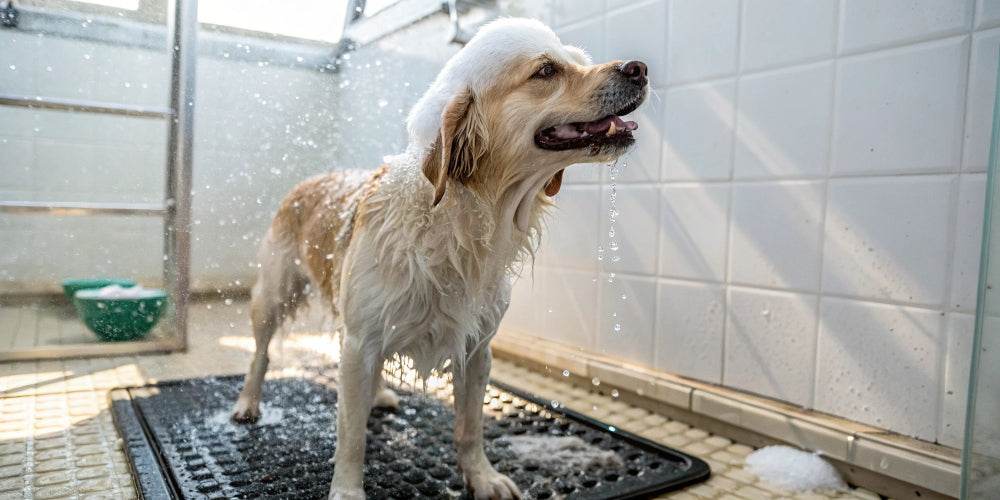
Why use a hypoallergenic shampoo for your dog?
Allergies in dogs often cause pets to experience itchy skin, which leads to persistent scratching, sometimes resulting in wounds and bleeding. Allergies are responsible for itching or itching of the skin., usually behind the ears, in the area underneath (belly, genitals and legs) and in hairless areas. This usually causes the dog to scratch frequently, as well as to lick or nibble the affected area and even rub against the walls or drag itself on the floor. In general, dog allergies, red skin, hives, burning and inflammation are very common and are not fatal, although attention should be paid. Keep in mind that these can affect the animal's mood, which can ultimately impact a loss of the pet's quality of life.
The use of the hypoallergenic shampoos For dogs, it's highly recommended in these cases. These can help your pet relieve the symptoms and skin changes they experience due to allergies—especially when your dog has contact dermatitis. Below, we explain why you should start using a hypoallergenic shampoo. We answer how to relieve a dog's itching with a special shampoo and what to do if my dog has skin allergies. Pay attention to our recommendations!
How to relieve a dog's itching: hypoallergenic dog shampoo
Hypoallergenic dog shampoo is a product that has been formulated with a special composition to minimize the risk of allergic reactions that your pet may have in relation to the product. These shampoos generally have a natural composition based on natural ingredients such as Aloe Vera or tea tree oil. The formulation contains low-reactive ingredients on the skin, therefore, these are products that are free of aromas, as well as colorants, preservatives and soaps. Despite all this, the hypoallergenic dog shampoo, or dog allergy shampoo, continues to perform its cleansing function, in addition to providing hydration to the pet—just like any other pet hair and skin cleaning product. Allergy shampoos for dogs with red skin usually contain key molecules to restore skin health, i.e., They work as a treatment.
What should I do if my dog has a skin allergy?
Dogs with allergies often develop skin dermatitis, which is why you'll need to purchase a product that protects the dog from allergens and potential bacterial infections, or even skin lesions such as eczema, scaling, or dry skin. Therefore, it's essential to purchase a dog allergy shampoo. However, it's recommended that your veterinarian diagnose the dog's allergy and rule out other potential problems such as hypothyroidism, mange, ringworm, and other autoimmune infections—as the problem can worsen if not addressed promptly. When it comes to pet grooming, choosing the right hypoallergenic dog shampoo is crucial, but it's also important to pay attention to the rest of your dog's bathing routine. We recommend keeping the following in mind:
- Room temperature: The ambient temperature of the place where you are going to bathe your dog should be warm, therefore, it is advisable to use some portable heaters, first of all.
- Water temperatureAnother thing to keep in mind is the water temperature. It should be lukewarm or tepid. Also, keep in mind that if the water is too hot—apart from potentially burning your pet—their skin will dilate more, which can make your little one's itching worse.
- Do a pre-washIf your dog is very dirty, you may need to pre-wash to remove most of the dirt, grease, flakes, or cell debris, and then wash it afterwards so the allergy shampoo can come into closer contact with the skin and perform its treatment function.
- Let the shampoo do its workRemember to let the product sit for at least 10 minutes. This way, the shampoo will be more effective, especially if it's in contact with your skin. Then, rinse the soap off with warm water and make sure to remove any foam that may have formed.
- The towelsWhen drying your dog, use clean, new towels and take advantage of the warm room temperature to avoid using a hairdryer as much as possible. Remember that hairdryers can be harsh on your pet's skin; your little one will feel a burning sensation.
In any case, remember that the most advisable thing to do in any situation in which your pet may have become ill is consult a veterinarianThis way, you'll be sure to understand what your dog's real problem is and that you're taking the necessary steps to prevent it from getting worse.
Other treatments to relieve itching in dogs and allergies
Allergy problems in dogs, including red skin, eczema, and other conditions, have various treatments, in addition to the use of hypoallergenic shampoos. Some of the recommendations and treatments are as follows:
- Change your pet's diet by replacing low-quality food with premium food or food specifically for dogs with allergies.
- Allergy vaccines with immunotherapy to reduce the need for other medications.
- Shampoos and external sprays to prevent potential bacterial or fungal infections, as well as other allergy-related symptoms that can intensify itching.
- Regular ear cleaning, especially for pets with drooping ears, as this increases the accumulation of moisture and makes them more susceptible to allergies and infections.
- Supplements and foods rich in Omega 3 fatty acids. These are highly recommended for relieving itching in dogs.


